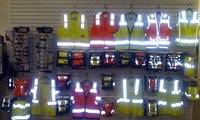Information About High Visibility Vests
6th Sep 2016
This is an excerpt from The American National Standards Institute, and it discusses information about safety vests and their different functional uses in the field.
-- "High Visibility Vests"
"For emergency personnel deployed on roadways in response to an accident or other emergency situation, high visibility vests serve as a first line of defense against dangerous highway traffic. The latest standard...outlines important design and performance criteria for vests worn by police officers, firefighters, emergency medical services (EMS) and other public safety personnel in such instances."
"...High Visibility Public Safety Vests, is specifically designed to increase the safety and visibility of these emergency responders. Particularly critical during low-light conditions and...combine fluorescent and retro-reflective materials for enhanced visibility under even the most compromised lighting conditions. The standard also includes important design options for break-away features. Fastened with Velcro rather than zippers, buttons or a sewn seam, break-away vests can be pulled quickly and easily away from a responder’s body, should it become caught on a passing vehicle.
ANSI/ISEA 207 also includes features specific to the needs of emergency responders, such as a cut-out side for police officer’s weapons or EMS belt-mounted equipment. The standard also specifies garment dimensions such that the vest can be sufficiently large enough to be worn over a firefighter’s coat. Finally, to clearly and visibly differentiate between different types of emergency personnel, ANSI/ISEA 207 also allows for color-specific markings on the vest panel or trim to distinguish between police, fire and EMS responders."
If you would like to read more about these standards please visit the link below that will take you directly to ansi.org where we pulled the above information from. Keep checking in with our blog to get additional information about the differences between vest classes.
https://www.ansi.org/news_publications/news_story.aspx?menuid=7&articleid=e46e8e2c-33b2-4338-8b21-bb438a321f4e

